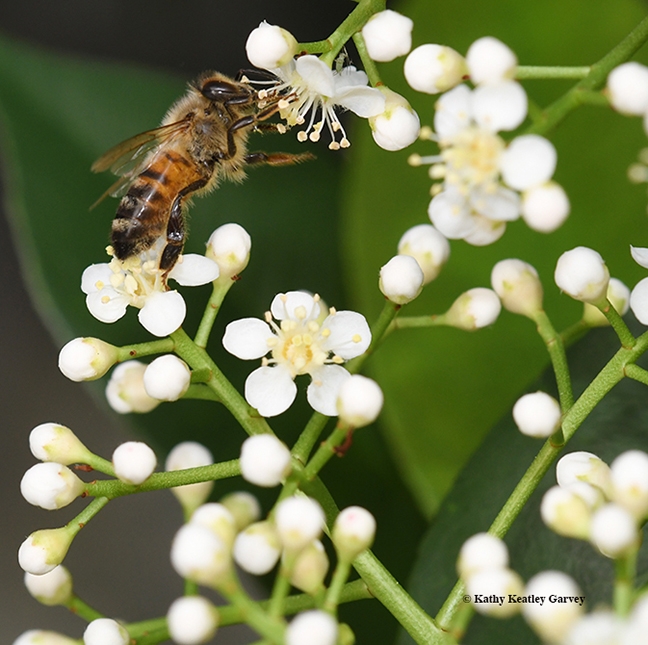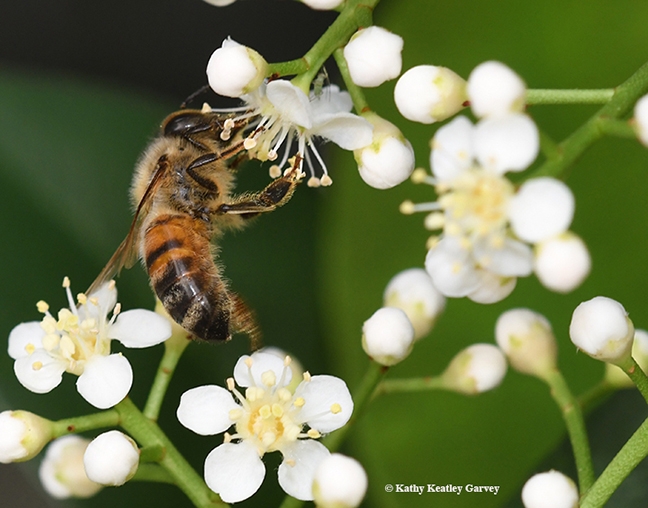- Author: Kathy Keatley Garvey
How often do you see a honey bee "standing upright" to reach nectar?
"Well, I guess I could just buzz up there and grab some nectar! But why not stay right here where I am and just s-t-r-e-t-c-h like a giraffe to get it?"
This bee, foraging on a Photinia blossom, almost looked like an athlete in training. Was she stretching to "warm up?" Was she stretching to improve performance? Flexibility? Mobility?
Me thinks she was just taking a short cut to the sweet stuff and being a little territorial as other bees buzzed around her.
Our honey bee will return to the hive where workers will process the nectar into honey. Humans will get some of it, too.
If you'd like to sample honey--and mix with entomologists--mark your calendar for Saturday, April 22 and "bee" at Briggs Hall for the annual honey tasting, just one part of the 200 some events at the 103rd annual UC Davis Picnic Day. It's an all-day campuswide open house aimed to educate, inform and entertain.


- Author: Kathy Keatley Garvey

That is, honey bees heading home to their colony.
Many beekeepers, especially beginning beekeepers, like to watch their worker bees--they call them "my girls"--come home. They're loaded with pollen this time of year. Depending on the floral source, it may be yellow, red, white, blue, red or colors in between.
Below, the girls are heading home to a bee observation hive located inside the conference room of the Harry H. Laidlaw Jr. Honey Bee Research Facility on Bee Biology Road, University of California, Davis.
They're bringing in food for the colony: pollen and nectar. They also collect water and propolis (plant resin). This is a matriarchal society where females do all the work in the hive. The worker bees--aptly named--serve as nurse maids, nannies, royal attendants, builders, architects, foragers, dancers, honey tenders, pollen packers, propolis or "glue specialists," air conditioning and/or heating technicians, guards and undertakers.
The glassed-in bee observation hive is indeed a popular and educational attraction to watch the queen lay eggs (she'll lay about 2000 eggs a day during peak season), the comb construction, honey production, pollen storage and all the other activities. The sisters feed the colony, including the queen and their brothers (drones). A drone's responsibility is solely reproduction, and that takes place in mid-air when a virgin queen takes her maiden flight. After mating, he dies. Done. That's it.
Meanwhile, life continues inside the hive.



- Author: Kathy Keatley Garvey
"Where do foraging bees go to die?"
That question was asked this week of honey bee guru Eric Mussen of the UC Davis Department of Entomology, who serves as the statewide Extension apiculturist.
"Do they return to the hive? Do they retire and live out their last days inside?" he was asked.
We've all seen worker bees in the throes of death. After all, they live only four to six weeks in the busy season. But the queen bee, which can lay some 2000 eggs a day, quickly replaces them.
"Since we do not know exactly where they go, we say that they fly off in the final moments of life, lose altitude and land on whatever is beneath them, moribund," Mussen says. "They are still able to sting for quite a few minutes, as can be attested to by neighbors who find moribund bees in their lawns or swimming pools, but they die relatively soon. Bees have enzyme systems that deal with flight and when the enzymes give out, so does flight."
Mussen points out that "a few of the dying bees, maybe 15 or so, of the 1,000 or more that die daily (in a colony) during the spring, summer, and fall, do die in--or in front of--the hive."
When those bodies lose some moisture, the "undertaker bees" carry away the lighter-weight bodies and drop them 150 feet or more away from the hive, studies show. "Most of the rest just drop, somewhere, when they no longer can forage or stay in the air," Mussen says. "Bees do fly up to four miles from the hive in any compass direction, so they drop out there in that 50-square mile area."


- Author: Kathy Keatley Garvey
'Tis the season for brotherly love, but not in the bee hive.
As the honey-gathering season ends and the weather turns colder, the worker bees (infertile females) push their brothers--the drones--out of the hive. Drones are of no use to the colony in the winter. They're another mouth to feed. (The sole function of the drones are to mate with the queen.)
So how are the worker bees able to shove the much-larger drones from the hive?
"The sisters quit feeding their brothers so that they're lighter and easier to push," said UC Davis apiculturist Eric Mussen.
UC Davis bee breeder-geneticist Susan Cobey admits to having a soft spot for the drones. “They’re cold and hungry, sitting there on the doorstep and wanting to go back in. They’re attacked and they die. Well, it’s a matriarchal society.”
It is.
A matriarchal society in the season of brotherly love.

- Author: Kathy Keatley Garvey
If you were a queen bee, you'd be laying about 1500 to 2000 eggs today. It's your busy season.
"She's an egg-laying machine," said bee breeder-geneticist Susan Cobey of the Harry H. Laidlaw Jr. Honey Bee Research Facility at UC Davis. "And she's the mother of all the bees in the hive." During the peak season, that amounts to about 50,000 to 80,000 workers (sterile females) and 1000 to 2000 drones (males).
Worker bees take care of her every need. They feed her, groom her and protect her, Cobey said, "and then they have the additional tasks of rearing and feeding her young."
The queen bee is easy to spot in the hive; she's the biggest bee. And wherever she goes, you'll see her court (workers) surrounding her.
Beekeepers mark her with a colored dot on her thorax so she's easily visible. (School children, when asked to single out the queen bee, say "She's the one with the dot!")
On her maiden flight, the queen bee mates with some 12 to 25 drones and then she heads back to the hive to lay eggs for the rest of her life, "usually two or three years," said Cobey, who is internationally renowned for her classes on "The Art of Queen Rearing" and "Instrumental Insemination and Bee Breeding."
The queen bee destroys any and all competitors for her "throne" by stinging and killing them. Unlike worker bees, she does not die after she stings.
Interestingly enough, only female bees can sting. Drones, or male bees, have no stingers (despite what Jerry Seinfeld's character said in The Bee Movie). Their only purpose is to mate with the queen. Then they die.
It's a matriarchal society. The girls (worker bees) do all the work; they serve as nurses, guards, grocers, housekeepers, construction workers, royal attendants and undertakers. It's not surprising, then, that during the summer, their life span is only four to six weeks.
Meanwhile, if you're the queen bee, there's no reproductive rest for you! You have about 1,999 more eggs to lay today.




